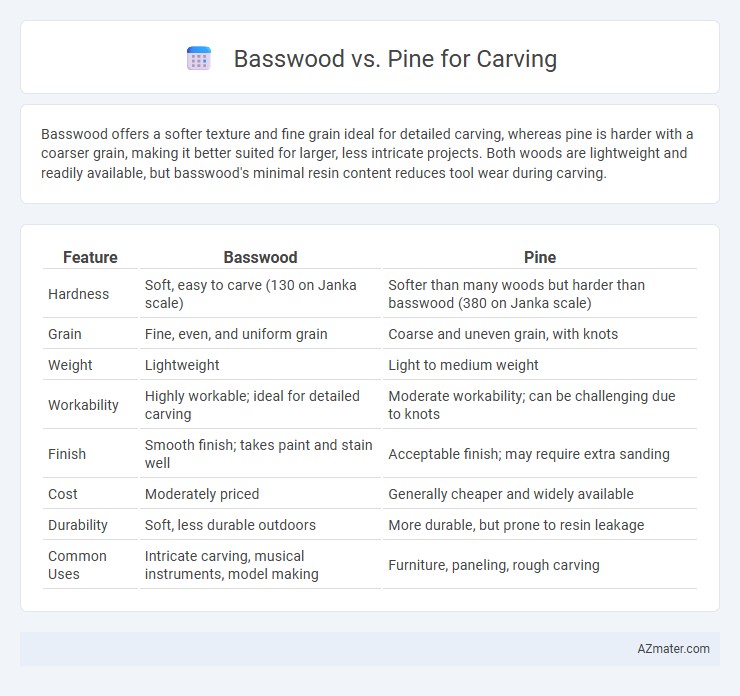Basswood offers a softer texture and fine grain ideal for detailed carving, whereas pine is harder with a coarser grain, making it better suited for larger, less intricate projects. Both woods are lightweight and readily available, but basswood's minimal resin content reduces tool wear during carving.
Table of Comparison
| Feature | Basswood | Pine |
|---|---|---|
| Hardness | Soft, easy to carve (130 on Janka scale) | Softer than many woods but harder than basswood (380 on Janka scale) |
| Grain | Fine, even, and uniform grain | Coarse and uneven grain, with knots |
| Weight | Lightweight | Light to medium weight |
| Workability | Highly workable; ideal for detailed carving | Moderate workability; can be challenging due to knots |
| Finish | Smooth finish; takes paint and stain well | Acceptable finish; may require extra sanding |
| Cost | Moderately priced | Generally cheaper and widely available |
| Durability | Soft, less durable outdoors | More durable, but prone to resin leakage |
| Common Uses | Intricate carving, musical instruments, model making | Furniture, paneling, rough carving |
Introduction to Basswood and Pine for Carving
Basswood is a popular choice for woodcarvers due to its fine grain, softness, and ease of shaping, making it ideal for detailed work and beginners. Pine, while harder and more resinous than basswood, offers affordability and availability but can be prone to splitting and uneven carving due to its grain. Both woods serve distinct purposes in carving projects depending on the desired finish and complexity of the design.
Wood Grain and Texture Comparison
Basswood features a fine, even grain and soft texture, making it ideal for detailed carving with smooth cuts and minimal resistance. Pine exhibits a more pronounced, coarser grain with occasional knots, which can affect carving precision and may require extra effort to achieve fine details. The consistent, tight grain of basswood allows for cleaner, more intricate carvings compared to the variable texture of pine.
Hardness and Workability Differences
Basswood is significantly softer than pine, making it easier to carve intricate details with minimal effort and producing a smoother finish. Pine's higher hardness can cause more wear on tools and requires greater skill to achieve fine detail without splintering. Carvers favor basswood for its consistent, fine grain and softness, while pine is preferred for projects needing durability and a rustic appearance.
Carving Tool Compatibility
Basswood's soft and fine-grained texture makes it highly compatible with a variety of carving tools, allowing for smooth cuts and intricate details without excessive wear on blades. Pine, while softer than hardwoods, contains resin and knots that can dull tools faster, requiring frequent sharpening and more durable carbide-tipped tools for efficient carving. Carvers often prefer basswood for delicate work and beginners due to its ease of shaping, whereas pine is suited for rougher, larger projects where tool longevity is less critical.
Detailing and Finish Quality
Basswood offers superior detailing due to its fine, even grain and soft texture, allowing for intricate carvings and smooth finishes with minimal effort. Pine, while more affordable and widely available, presents a coarser grain that can obscure fine details and may require more sanding for a polished finish. The choice between basswood and pine significantly impacts the precision of carved details and the overall quality of the finish.
Availability and Cost Factors
Basswood and pine are widely favored for carving due to their accessibility and affordability, with basswood being more readily available in craft stores and online retailers, often priced moderately higher due to its finer grain and softness. Pine's abundant presence in North America and faster growth rate make it a cost-effective option, especially for large projects or beginners. While pine offers budget-friendly choices, basswood's consistent texture justifies its cost for detailed and precise carving work.
Suitability for Beginners and Experts
Basswood offers a fine, even grain and soft texture that makes it ideal for beginners learning carving techniques, providing ease in detail work without excessive resistance. Pine, while more affordable and readily available, presents a tougher, resinous texture with more knots, which can challenge novices but offers experts an opportunity to develop advanced skills and achieve rugged, rustic designs. Carvers should consider basswood for smooth, precise projects and pine for textured, character-rich creations depending on their skill level.
Durability and Longevity of Carvings
Basswood offers superior durability for detailed carving due to its fine, uniform grain, which resists splintering and holds intricate designs well over time. Pine, being softer and more resinous, is prone to dents and may degrade faster when exposed to environmental factors, reducing the longevity of carvings. For long-lasting, durable carvings that maintain their detail, basswood remains the preferred choice among woodcarvers.
Common Projects for Each Wood Type
Basswood is ideal for intricate, detailed carvings such as figurines, small sculptures, and decorative ornaments due to its soft texture and fine grain. Pine is commonly used for larger, rougher projects like furniture, signs, and rustic decor where durability and a more pronounced grain pattern are desired. Both woods are popular among carvers, with basswood favored for precision work and pine preferred for structural or decorative pieces requiring strength.
Final Recommendations: Choosing Between Basswood and Pine
Basswood offers a softer texture and finer grain, making it ideal for detailed and intricate carving projects, while pine provides a harder surface suitable for larger, sturdier carvings with a rustic appearance. When selecting between basswood and pine, consider basswood for ease of carving and smooth finishes, especially for beginners and delicate designs, whereas pine is better for durable, outdoor-friendly carvings. Prioritize the project's detail level and environmental exposure to ensure the wood choice aligns with your carving goals and durability needs.

Infographic: Basswood vs Pine for Carving
 azmater.com
azmater.com